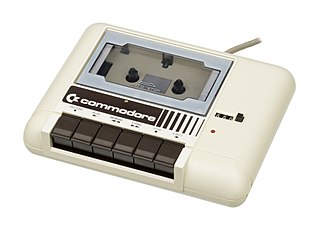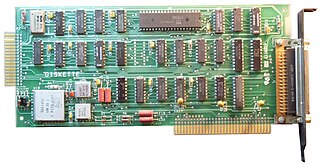
The Commodore 1541 is a floppy disk drive which was made by Commodore International for the Commodore 64 (C64), Commodore's most popular home computer. The best-known floppy disk drive for the C64, the 1541 is a single-sided 170-kilobyte drive for 5¼" disks. The 1541 directly followed the Commodore 1540.

The Commodore 1581 is a 3½-inch double-sided double-density floppy disk drive that was released by Commodore Business Machines (CBM) in 1987, primarily for its C64 and C128 home/personal computers. The drive stores 800 kilobytes using an MFM encoding but formats different from the MS-DOS, Amiga, and Mac Plus formats. With special software it's possible to read C1581 disks on an x86 PC system, and likewise, read MS-DOS and other formats of disks in the C1581, provided that the PC or other floppy handles the "720 kB" size format. This capability was most frequently used to read MS-DOS disks. The drive was released in the summer of 1987 and quickly became popular with bulletin board system (BBS) operators and other users.

The Commodore 1571 is Commodore's high-end 5¼" floppy disk drive, announced in the summer of 1985. With its double-sided drive mechanism, it has the ability to use double-sided, double-density (DS/DD) floppy disks, storing a total of 360 kB per floppy. It also implemented a "burst mode" that improved transfer speeds, helping address the very slow performance of previous Commodore drives.

A floppy disk or floppy diskette is a type of disk storage composed of a thin and flexible disk of a magnetic storage medium in a square or nearly square plastic enclosure lined with a fabric that removes dust particles from the spinning disk. The three most popular floppy disks are the 8-inch, 5¼-inch, and 3½-inch floppy disks. Floppy disks store digital data which can be read and written when the disk is inserted into a floppy disk drive (FDD) connected to or inside a computer or other device.
In computer science, group coded recording or group code recording (GCR) refers to several distinct but related encoding methods for representing data on magnetic media. The first, used in 6250 bpi magnetic tape since 1973, is an error-correcting code combined with a run-length limited (RLL) encoding scheme, belonging into the group of modulation codes. The others are similar encoding methods used in mainframe hard disks or microcomputer floppy disks until the late 1980s. GCR is a modified form of a NRZI code, but necessarily with a higher transition density.

The Commodore 1530 (C2N) Datasette, later also Datassette, is Commodore's dedicated magnetic-tape data storage device. Using compact cassettes as the storage medium, it provides inexpensive storage to Commodore's 8-bit computers, including the PET, VIC-20, and Commodore 64. A physically similar model, Commodore 1531, was made for the Commodore 16 and Plus/4 series computers.

The Commodore SX-64, also known as the Executive 64, or VIP-64 in Europe, is a portable, briefcase/suitcase-size "luggable" version of the popular Commodore 64 home computer and the first color portable computer.
Sirius Systems Technology was a personal computer manufacturer in Scotts Valley, California. It was founded in 1980 by Chuck Peddle and Chris Fish, formerly of MOS Technology and capitalized by Walter Kidde Inc. In late 1982 Sirius acquired Victor Business Systems from Kidde and changed its name to Victor Technologies. It made the Victor/Sirius series of personal computers. The company made a public stock offering in the first half of 1983, but went into Chapter 11 protection from bankruptcy before the end of 1984. The company's assets were acquired by Datatronic AB, a Swedish software/hardware distribution company headed by Mats Gabrielsson. Gabrielsson signed a distribution deal with Kyocera, which began to supply PC clones to Victor.

Commodore DOS, also known as CBM DOS, is the disk operating system used with Commodore's 8-bit computers. Unlike most other DOSes, which are loaded from disk into the computer's own RAM and executed there, CBM DOS is executed internally in the drive: the DOS resides in ROM chips inside the drive, and is run there by one or more dedicated MOS 6502 family CPUs. Thus, data transfer between Commodore 8-bit computers and their disk drives more closely resembles a local area network connection than typical disk/host transfers.

In computer storage, zone bit recording (ZBR) is a method used by disk drives to optimise the tracks for increased data capacity. It does this by placing more sectors per zone on outer tracks than inner tracks. This contrasts with other approaches, such as constant angular velocity (CAV) drives, where the number of sectors per track are the same. On a disk consisting of roughly concentric tracks, whether realized as separate circular tracks or as a single spiral track, the physical track length (circumference) is increased as it gets further from the centre hub.

The Commodore 4040 is the replacement for the previous models 2040 (U.S.) and 3040 (Europe). It's a dual-drive 5¼" floppy disk subsystem for Commodore Business Machines. It uses a wide-case form, and uses the parallel IEEE-488 interface common to Commodore PET/CBM computers.
Floppy disk format and density refer to the logical and physical layout of data stored on a floppy disk. Since their introduction, there have been many popular and rare floppy disk types, densities, and formats used in computing, leading to much confusion over their differences. In the early 2000s, most floppy disk types and formats became obsolete, leaving the 3+1⁄2-inch disk, using an IBM PC compatible format of 1440 KB, as the only remaining popular format.

A floppy-disk controller (FDC) is a hardware component that directs and controls reading from and writing to a computer's floppy disk drive (FDD). It has evolved from a discrete set of components on one or more circuit boards to a special-purpose integrated circuit or a component thereof. An FDC is responsible for reading data presented from the host computer and converting it to the drive's on-disk format using one of a number of encoding schemes, like FM encoding or MFM encoding, and reading those formats and returning it to its original binary values.

The Commodore 64 home computer used various external peripherals. Due to the backwards compatibility of the Commodore 128, most peripherals would also work on that system. There is also some compatibility with the VIC-20 and Commodore PET.

Fast Hack'em is a Commodore 64 fast disk/file copier, nibbler and disk editor written by Mike J. Henry and released in 1985. It was distributed in the U.S. and Canada via Henry's "Basement Boys Software", and in the U.K. via Datel Electronics. In the U.S., it retailed for $29.95.

A fast loader is a software program for a home computer, such as the Commodore 64 or ZX Spectrum, that accelerates the speed of file loading from floppy disk or compact cassette.

The MSD Super Disk were a series of 5¼-inch floppy disk drives compatible to some degree with the Commodore 1541 disk drive. produced by Micro Systems Development for use with Commodore 8-bit home computers. Two different versions of the MSD Super Disk were available: the single-drive model, SD-1; and the dual-drive model, SD-2.
Blue Board is a bulletin board system software created by Martin Sikes (1968–2007) for the Commodore 64 in the 1980s in Vancouver, British Columbia, Canada, and sold worldwide. Due to optimized code and memory allocation, Blue Board boasted very fast performance for a BBS on that hardware platform. In fact, Blue Board was faster than most if not all BBSs run on 8-bit computers. This speed combined with its use of the ASCII character set and XModem file transfer protocol rather than PETSCII and the Commodore-specific Punter protocol sometimes led users to believe that they were calling a BBS running on a much larger and faster computer.
Amiga support and maintenance software performs service functions such as formatting media for a specific filesystem, diagnosing failures that occur on formatted media, data recovery after media failure, and installation of new software for the Amiga family of personal computers—as opposed to application software, which performs business, education, and recreation functions.

The floppy disk is a data storage and transfer medium that was ubiquitous from the mid-1970s well into the 2000s. Besides the 3½-inch and 5¼-inch formats used in IBM PC compatible systems, or the 8-inch format that preceded them, many proprietary floppy disk formats were developed, either using a different disk design or special layout and encoding methods for the data held on the disk.














